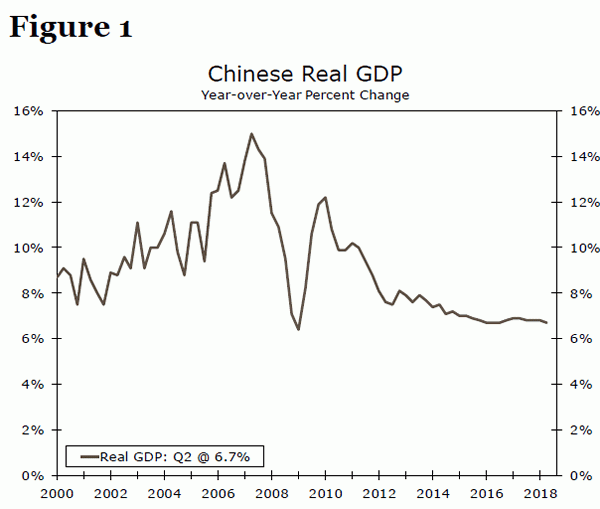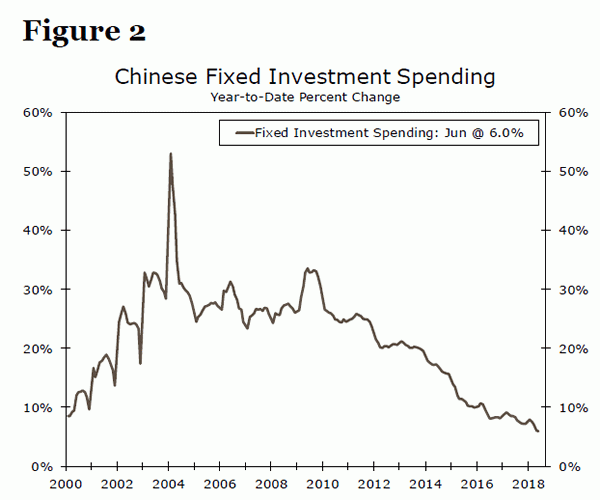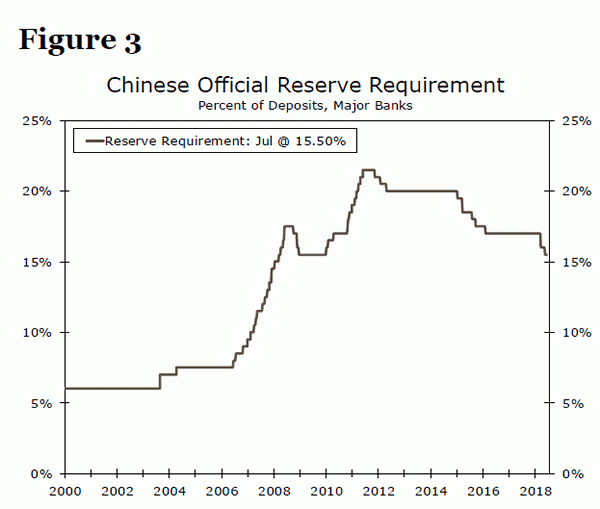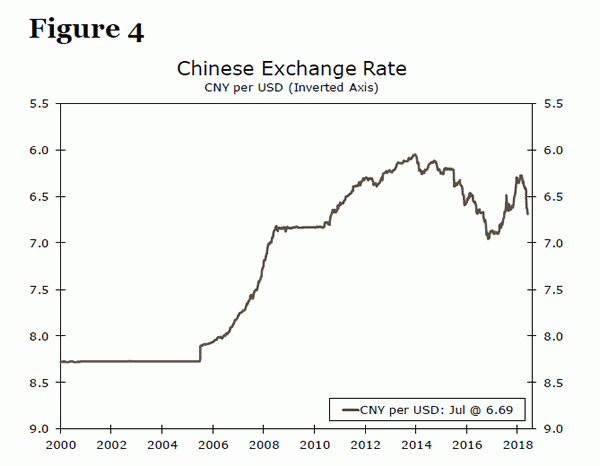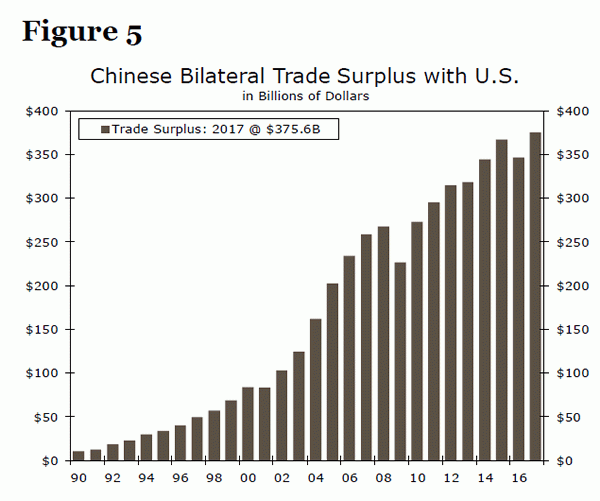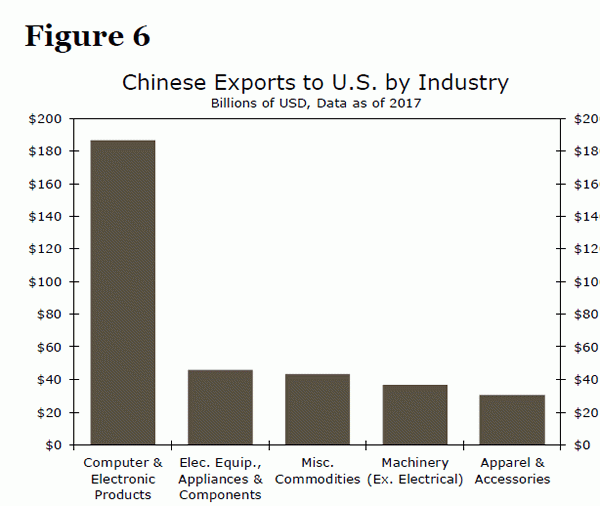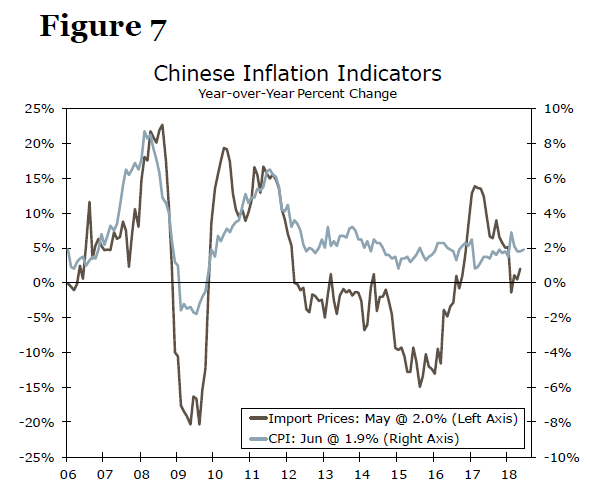Executive Summary
Real GDP growth in China slowed slightly in Q2-2018, but the slowdown was in line with expectations. Retail sales growth helped prop up economic growth, as industrial production and investment spending both continued to decelerate in the quarter. These trends largely pre-dated recent trade actions, however, as Chinese policymakers have worked to combat rapidly high debt levels and shift the economy toward a more consumption-oriented economic model. A brewing trade war with the United States may have exacerbated this structural trend at the margin as uncertainty weighs on fixed investment.
Despite rampant trade war fears, we look for real GDP growth in China to slow to 6.6 percent in 2018 and 6.0 percent in 2019, down from 6.9 percent in 2017. Our outlook for slower but still-solid growth is underpinned by a few factors. First, Chinese policymakers have the firepower and will to help stimulate the economy if necessary, either by easing monetary policy, providing fiscal stimulus or some combination of the two. Second, though Chinese exports to the United States amount to be about 4 percent of GDP, this figure overstates China’s true exposure, as an exported final product often has value added by multiple countries along the way.
The most recent threat by the Trump administration to impose a 10 percent tariff on $200 billion in Chinese goods represents a downside risk to our forecast, but whether the United States will follow through on this threat and when such a proposal would take effect remains to be seen. As more details emerge on the newest tariff threats, we will monitor them closely and update our forecast accordingly. In short, we think that tariffs would cause growth in Chinese exports to the United States to slow, but the hit to exports probably would not be large enough to cause the $12 trillion Chinese economy to slide into outright recession.
Real GDP Growth in Line with Modest Slowdown
Data released today showed that real GDP in China slowed to 6.7 percent year over year in Q2, down slightly from the 6.8 percent registered in Q1 (Figure 1). Coming into today, monthly data for the second quarter suggested a slight slowdown in GDP growth was in store, and June data on consumption and investment, also released today, confirmed this suspicion. Industrial production growth fell to 6.0 percent year over year in June from 6.8 percent in May, and although retail sales growth bounced back in June from a historically slow pace in May, it remained shy of the doubledigit pace registered for most of this expansion..
Data on fixed investment spending in China help tell the story of a gradually decelerating economy. Fixed investment spending growth through H1-2018 was the slowest on record (Figure 2). Over the past few decades, explosive investment growth and capital deepening helped power the Chinese economy to supercharged growth rates that surpassed much of the advanced world. For most of this cycle, however, investment spending has been decelerating, particularly over the past few years as leverage concerns have risen and policymakers have pushed harder to shift toward a more consumption-oriented economic model. With structural factors like these in the background and more immediate uncertainty being generated by trade war fears, it is not altogether surprising that investment spending growth continued to slow in H1-2018.
Monetary Policy Is Slowly Turning More Accommodative
Signs of slower growth that were referenced above may have contributed to the June 24 decision by the People’s Bank of China (PBoC) to cut the required reserve ratio (RRR) for major banks from 16.00 percent to 15.50 percent (Figure 3). Interbank interest rates crept higher in May, and real GDP growth could be negatively affected if higher rates were to be sustained. The cut in the RRR had the effect of instantly creating more liquidity in the banking system, and interbank interest rates have subsequently receded. The year-over-year rate of economic growth in China has trended lower since early 2010, and the PBoC has cut the RRR 600 bps over that period. If, as we expect, real GDP growth in China slows further in coming quarters, then it seems reasonable that the PBoC will continue to reduce the RRR going forward.
That said, any RRR reductions that occur likely will take place at a measured pace. The Chinese renminbi has been under some downward pressure in recent weeks in part due to concerns about a potential trade war between the United States and China (Figure 4). But the RRR reduction, which as noted above has led to lower interbank rates, has contributed to the softness in the value of the Chinese currency. Chinese authorities do not want to see a sharp depreciation of the currency because it could lead to volatility in other financial markets, which could have a negative effect on economic growth. Therefore, we believe that further reductions in the RRR will take place at a measured rate because a fast rate of RRR reductions could potentially lead to sharp depreciation in the currency.
How Painful Would a Trade War Be for China?
In 1990, Chinese exports to the United States totaled only $15 billion, while the United States sent a paltry $5 billion worth of goods back to China. Consequently, China ran a small bilateral trade surplus with the United States that was worth $10 billion in 1990 (Figure 5). But over the past three decades, trade between China and the United States has skyrocketed. Last year, the value of Chinese exports to the United States ($505 billion) exceeded the value of American exports to China ($130 billion) by $375 billion. It is this marked widening in the bilateral trade deficit that has provoked the ire of the Trump administration. As of this writing, the administration has levied tariffs on Chinese exports of steel and aluminum products, on $34 billion worth of other products, with $16 billion still pending and threatened tariffs on $200 billion or more of other Chinese goods. It remains to be seen whether the United States will follow through on this last point. Should the United States follow through, an effective date remains unknown at this time, although public hearings on the proposal are scheduled for August 20-23. The proposed tariff on the $200 billion threat is 10 percent, down from the 25 percent tariff enacted on July 6 on the first $50 billion in goods.
What exactly does China export to the United States? The top five products groups, which collectively account for two-thirds of total Chinese exports to the United States, are shown in Figure 6. Computer & electronic products are by far the largest export category, with Chinese exports of these goods to the United States totaling $187 billion in 2017. Not only does this broad category include desktop and laptop computers and tablets, but it also includes mobile phones. As noted previously Chinese exports to the United States totaled $505 billion in 2017, which was equivalent to about 4 percent of Chinese GDP. Chinese economic growth has already downshifted from the breakneck pace of the early years of this decade, and a serious hit to Chinese exports from American tariffs could potentially impart another slowing shock on the Chinese economy.
However, the absolute export figure of $505 billion overstates the exposure that the Chinese economy has to exports to the United States. As noted above, the value of computers and mobile phones account for a sizeable share of Chinese exports to the United States. But China imports significant quantities of semiconductors and other electronic components from other countries to make these finished products. The computers and mobile phones that the United States imports may be labeled as “Made in China,” but it may be more accurate to label them as “Assembled in China.” In other words, the value added (profits and wages) that is generated in China from the export of computer & electronic products to the United States is far less than the value of these products, which totaled $187 billion in 2017.
Data from the Organisation for Economic Cooperation and Development (OECD) support this assertion. Total exports of the computer, electronic & optical equipment industry in China were equivalent to 2 percent of Chinese GDP in 2011 (latest available data). However, these exports accounted for only 0.4 percent of the value added that was generated in China in that year. In short, the Chinese economy does not appear to be quite as exposed to exports to the United States that the $505 billion would suggest.1
Looking at the situation the other way around, the tariffs that China has levied thus far on $34 billion worth of American goods (e.g., soybeans, seafood, pork, and electric vehicles) will likely lead to higher prices of those goods in China, but they probably will not have a meaningful effect on the overall rate of CPI inflation in China. As shown in Figure 7, there is a fair degree of correlation between changes in Chinese import prices and CPI inflation.2 However, the sensitivity of the overall rate of CPI inflation to changes in import prices is rather low.
The bottom line is that a trade war would have some negative effects on China, but it probably would not be completely debilitating for that country either. Tariffs would cause growth in Chinese exports to the United States to slow, but the hit to exports probably would not be large enough to cause the $12 trillion Chinese economy to slide into outright recession, even if the negative effect on investment in the affected industries is taken into consideration. CPI inflation in China will probably edge higher from the imposition of retaliatory tariffs on American goods, but a marked and sustained rise in the inflation rate probably would not be in the cards either.
Conclusion
Real GDP growth in China slowed slightly in Q2-2018 just as a potential China-United States trade war started heating up. As we look toward the second half of the year and 2019, we expect Chinese economic growth to slow, but in a manageable way consistent with an economy that faces structural headwinds from high private sector debt levels and an aging population. Tariffs represent a potential downside risk to our forecast, but the hit to exports probably would not be large enough to cause the $12 trillion Chinese economy to slide into outright recession. The authorities in China have a strong interest in preventing growth from slowing too sharply, and they would likely take the policy steps necessary to prevent such a development. As more details emerge on the newest tariff threats, we will monitor them closely and update our forecast accordingly. For now, we look for real GDP growth in China to slow to 6.6 percent in 2018 and 6.0 percent in 2019, down from 6.9 percent in 2017.
1 In 2011, Chinese exports to the United States totaled $400 billion, which was equivalent to more than 5 percent of Chinese GDP in that year. The OECD data show that total exports to the United States generated about 3.8 percent of value added in the Chinese economy in 2011.
2 The correlation coefficient between these two variables over the January 2006 through April 2018 period is 0.72.




